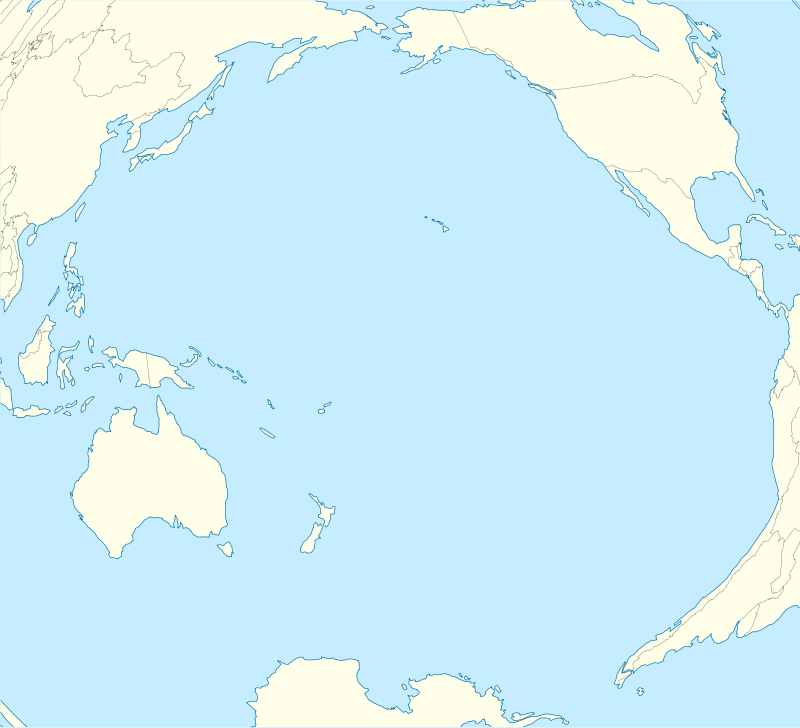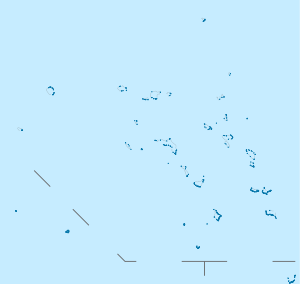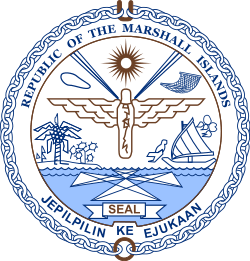Mili Atoll

|
NASA picture of Mili Atoll | |
 Mili Atoll | |
| Geography | |
|---|---|
| Location | North Pacific |
| Coordinates | 06°08′00″N 171°55′00″E / 6.13333°N 171.91667°E |
| Archipelago | Ratak |
| Total islands | 92 |
| Area | 14.9 km2 (5.8 sq mi) |
| Highest elevation | 3 m (10 ft) |
| Administration | |
| Demographics | |
| Population | 1032 (1998) |
| Ethnic groups | Marshallese |
Mili Atoll (Marshallese: Mile, [mʲilʲee̯][1]) is a coral atoll of 92 islands in the Pacific Ocean, and forms a legislative district of the Ratak Chain of the Marshall Islands. It is located approximately 78 kilometres (48 mi) southeast of Arno Its total land area is 14.9 square kilometres (5.8 sq mi) making it the second largest of the Marshall Islands after Kwajalein. It encloses a much smaller lagoon than Kwajalein, with an area of 760 square kilometres (290 sq mi). The atoll is separated by a water channel called the Klee Passage from the Knox Atoll which is considerably smaller. The population of Mili Atoll was 1032 as of 1999. The main village is also called Mili. Other villages include Nallu, Enejet, Lukonor, Tokewa, and Wau, Mili. Nallu, Enejet and Lukonwor are only accessible from Mili by land during lowtide. Only Mili, Mili and Enejet, Mili have runways for small planes. Mili Airport and Enejit Airport are served by Air Marshall Islands when its aircraft are operational.
History
The British merchant vessel Rolla sighted several islands in the Ratak and Ralik Chains. On 30 October 1803 she sighted islands at 5°41′N 169°27′E / 5.683°N 169.450°E, which was possibly Mili Atoll. Captain Cummings sent in a cutter, but the heavy surf prevented it from landing. Rolla had transported convicts from Britain to New South Wales and was on her way to Canton to find a cargo to take back to Britain.
In the early 19th century, Mili and Knox Atolls were designated the Mulgrave Islands by Adam Johann von Krusenstern. In 1823 her mutinous crew brought the whaler Globe, out of Nantucket, Massachusetts, to Mili Atoll by [2] Samuel B. Comstock, “Bloody Sam”, had killed Globe's captain and her three officers. A few days after she anchored at Mili Atoll, his co-mutineer Silas Payne murdered Comstock. Six of the crew fled in the ship, leaving nine men stranded on the island. By the time the U.S. schooner Dolphin, commanded by Lieutenant Commander John Percival, arrived to rescue them two years later, the islanders had killed all but two of the crew members.
The infamous blackbirder Bully Hayes owned Tokowa Islet on Mili during the late 19th century and used it as a base for his operations. Mili Atoll was claimed by the German Empire along with the rest of the Marshall Islands in 1884. The Germans established a trading station and in 1870 a Christian church.
World War II
After World War I, the island came under the South Pacific Mandate of the Empire of Japan. Mili housed a radio direction finding beacon and a weather station and the atoll was fortified by the Japanese military. The garrison was composed of 2,045 men of the Imperial Japanese Navy and 2,237 men of the Imperial Japanese Army.[3] In 1942 a seaplane base was developed. Between late 1942 and late 1943, the Japanese also constructed a land airfield with three runways (4750 ft, 4550 ft and 4400 ft), and numerous support buildings, including a radar station. The perimeter of the island was fortified with coastal defense and anti-aircraft guns. Between mid-1943 and August 1945, Mili was bombed by United States Navy carrier-based aircraft and shelled by warships. The attacks increased in frequency and severity after Majuro and Kwajalein had fallen to the United States. Of the 5100-man Japanese garrison (2600 Imperial Japanese Navy and 2500 Imperial Japanese Army) only half survived to the end of the war.[4] On 22 August 1945 the Japanese garrison commander surrendered his forces on board the USS Levy (DE-162).[5]
Postwar
Following the end of World War II, Mili Atoll came under the control of the United States as part of the Trust Territory of the Pacific Islands. The island has been part of the independent Republic of the Marshall Islands since 1986.
Mili remains littered with thousands of World War II relics. The law forbids these items from being removed from the island. Mostly what remains are large bunker systems, rail systems, old artillery pieces and remnants of aircraft. Examples include Japanese Zeroes and a B-25 Mitchell bomber sitting in just several feet of water. The ground is still covered with craters created by the artillery campaigns that lasted 30 days to "prep" the island for the Allied invasion.
While thousands of unexploded munitions were destroyed by Peace Corps volunteers in the 1960s, there remains danger for humans perceived from warfare chemicals in Japanese and U.S. unexploded munitions on land and in the ocean (which could enter the food chain).[6]
Notes
- ↑ Marshallese-English Dictionary - Place Name Index
- ↑ Hussey, Cyrus M; Lay, William (1828). "A Narrative of the Mutiny, on Board the Ship Globe, of Nantucket, in the Pacific Ocean, Jan. 1824, And the journal of a residence of two years on the Mulgrave Islands; with observations on the manners and customs of the inhabitants". New-London: Wm.-Lay and C.M. Hussey. Retrieved 2010-02-19.
- ↑ Takizawa, Akira; Alsleben, Allan (1999–2000). "Japanese garrisons on the by-passed Pacific Islands 1944-1945". Forgotten Campaign: The Dutch East Indies Campaign 1941-1942.
- ↑ WWII Sites on Mili Atoll
- ↑ "Levy". Naval History & Heritage Command. Retrieved 2 June 2013.
- ↑ Charlene Sakoda (March 20, 2014). "Island in the Pacific is home to countless WWII relics".
References
- L, Klemen (1999–2000). "Forgotten Campaign: The Dutch East Indies Campaign 1941-1942".
- WWII sites on Mili Atoll
External links
- Entry at Oceandots.com at the Wayback Machine (archived December 23, 2010)
- Surrender of Mili Atoll in WWII
- Pacific Wrecks

